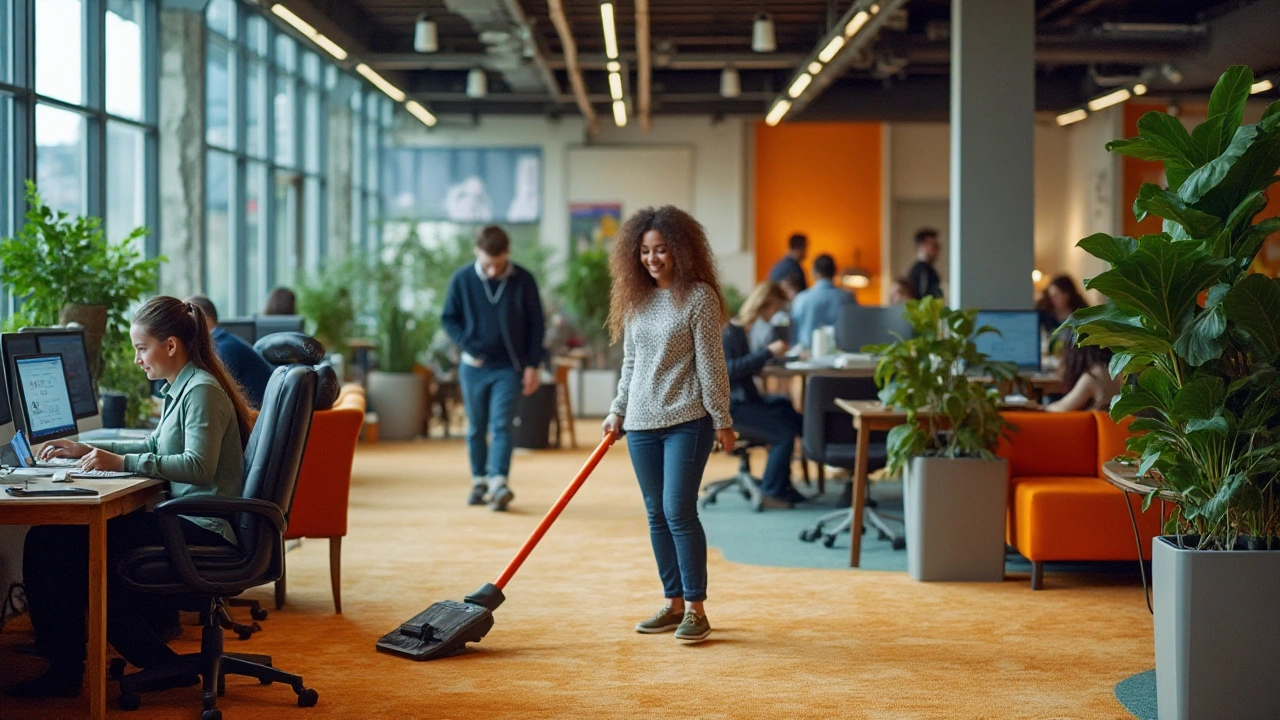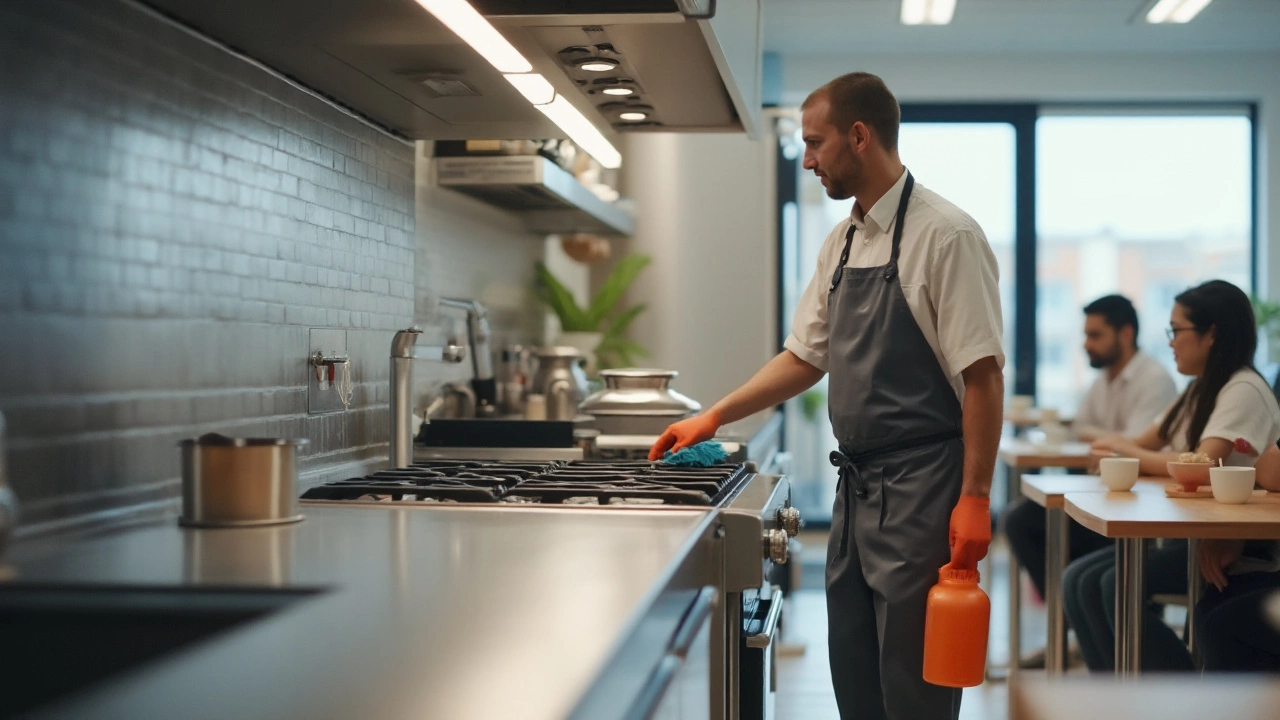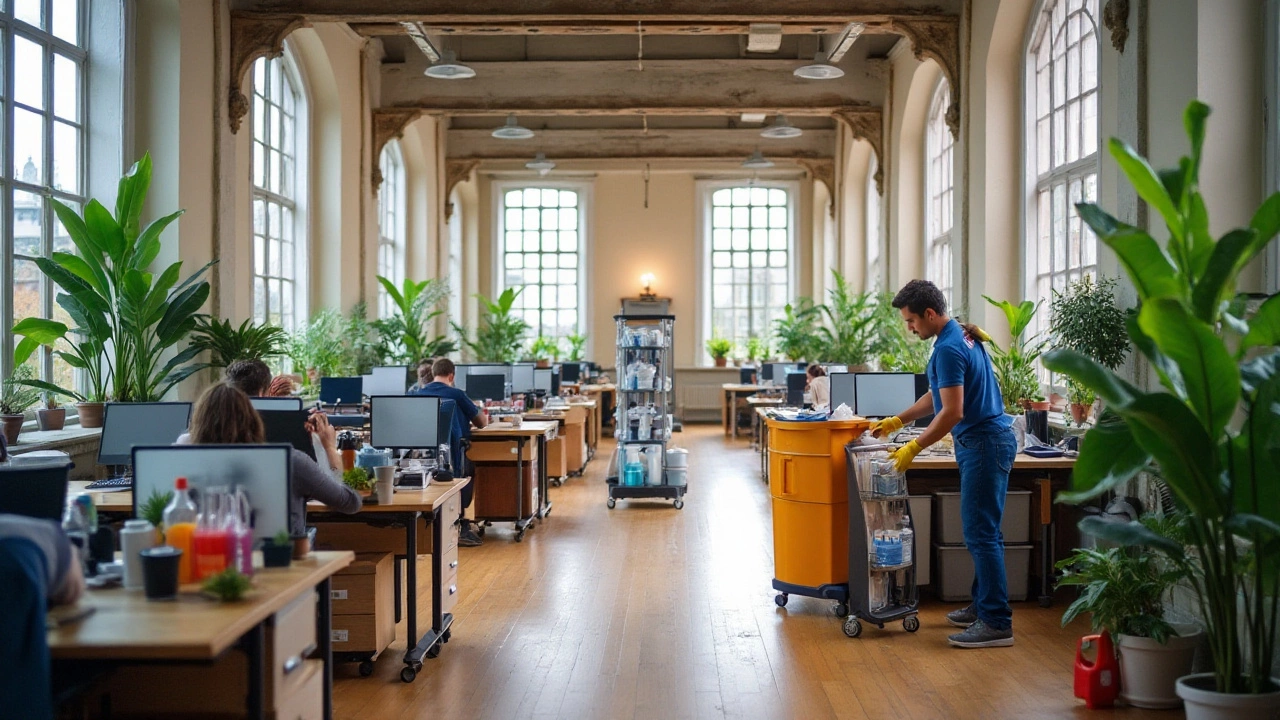In today's bustling offices, maintaining a clean environment isn't just about appearance; it's about creating a space where productivity and wellbeing thrive. With the complexities of modern workspaces, understanding how often to clean can be a challenging task. This article aims to offer clear and insightful guidance on scheduling office cleaning effectively.
As we navigate post-pandemic life, the emphasis on cleanliness has intensified. A well-maintained office contributes to a healthier workforce by minimizing the spread of germs and allergens. But how do you determine the right frequency for cleaning different areas in the office? Whether it's daily sprucing or deep cleaning sessions, everyone's needs are different. The following sections provide a roadmap to discovering the perfect balance for your workspace, combining hygienic standards with everyday practicality.
- The Importance of a Clean Office
- Determining Cleaning Frequency
- Special Areas with Unique Needs
- Tips for Developing a Cleaning Schedule
The Importance of a Clean Office
A clean office is more than just a visual appeal. It ties directly into the health and efficiency of the workspace. Dust-covered desks and cluttered meeting rooms can affect more than just air quality, they can lead to distractions that negatively impact productivity. But when the space is neat, tasks become easier, stress levels plummet, and the workforce operates in harmony. Regular cleaning routines help in maintaining this equilibrium, making it an essential part of any workplace strategy.
There’s a fascinating correlation between cleanliness and employee morale. Imagine walking into a pristine conference room versus a visibly disorderly one; the difference in how you feel about the tasks ahead can be palpable. Recent studies suggest that employees working in clean offices are often more motivated and positive. This isn’t merely psychological; the direct health benefits are significant, especially when regular cleaning prevents the accumulation of dirt that harbors germs and allergens. In fact, the CDC (Centers for Disease Control and Prevention) highlights that routine cleaning practices can significantly reduce the spread of illness in communal spaces.
Addressing office hygiene is no small feat. This becomes particularly evident in high-traffic zones such as receptions or shared kitchens. These spaces require focused attention because they are breeding grounds for bacteria if neglected. Access to proper cleaning supplies and a clear cleaning schedule is crucial for these areas. Each office is unique in its makeup and usage, thus necessitating a tailored approach. Such personalized attention ensures both the well-being of employees and the smooth operation of daily business activities.
Interestingly, the concept of cleaning as a catalyst for creativity is gaining attention. A tidy workplace, absent of unnecessary clutter, enhances creative thinking. Without visual distractions, your mind is free to wander and build connections more effectively. Employees have reported feeling empowered to think outside the box when their environment supports rather than stifles their innovative efforts. A quote from Marie Kondo encapsulates this well, "The objective of cleaning is not just to clean, but to feel happiness living within that environment." This clean ideology applies to not just homes but offices, too.
Finally, understanding and implementing effective cleaning schedules benefit not only health but economic metrics as well. Companies save funds by reducing sick days and avoiding the expenses that often accompany deep cleans of a neglected office. Numbers back this up; according to a survey from ISSA, workplaces practicing regular, thorough cleaning save roughly 20% on building maintenance costs annually. Thus, incorporating efficient cleaning schedules directly corresponds to economic health, affecting the bottom line positively. For these reasons and more, maintaining cleanliness in the office is a critical element in business operations.

Determining Cleaning Frequency
Deciding how often an office should be cleaned involves several factors, each requiring thoughtful consideration. First and foremost is the number of people using the space. A large open-plan office bustling with employees will necessitate a more frequent cleaning regimen compared to a small firm with a quieter footprint. In fact, it's widely acknowledged that a bustling workplace needs attention at least once a day, targeting critical areas where germs are most likely to accumulate. These include personal workstations, bathrooms, and entry points into the building. Implementing a rigorous cleaning schedule not only keeps the space tidy but also plays an essential role in maintaining employee health and reducing absenteeism.
The type of work conducted in the office also significantly affects the cleaning needs. For example, offices that handle paperwork or information technology might need less frequent heavy-duty cleaning compared to those in creative industries, where materials and equipment generate more dust and debris. It's prudent to remember that the use of shared equipment like printers, copiers, and computer stations demands regular disinfecting. According to the Center for Disease Control and Prevention, "High-touch surfaces should ideally be cleaned and disinfected daily." This directive underscores the importance of vigilance in cleaning schedules to ensure a safe, healthy environment for employees.
Geographical location might impact the frequency as well. Offices situated in urban environments with high external pollution levels or those located in areas with varying weather conditions could require specialized cleaning strategies. Dirt and grime from outside can quickly make their way into a building, especially during rainy or windy days. As such, scheduling frequent floor and window cleaning might be necessary to combat these external factors. Additionally, utilizing entrance mats can significantly reduce the amount of outdoor dirt migrating indoors. This simple step forms the first line of defense in a meticulous cleaning strategy.
Another key factor is the type of flooring and furniture materials in the office, as these can dictate cleaning needs. Carpets might need vacuuming or steam cleaning more frequently compared to hard floors that are easier to mop. Similarly, leather office chairs may require different cleaning techniques than fabric seats. Additionally, indoor air quality can be affected by how often filters in HVAC systems are replaced or serviced, influencing the overall need for cleaning—another aspect often overlooked when setting cleaning schedules. In essence, aligning cleaning routines with the specific requirements of an office's furnishings and infrastructure can significantly enhance their longevity and appearance.
Budget constraints and resource availability should also be considered when determining cleaning frequency. Understanding how much an organization is willing to invest in cleaning services can guide the planning process, allowing for optimal allocation of available funds without compromising hygiene standards. Outsourcing professional cleaning services or employing in-house janitorial staff are both viable options, each possessing unique advantages. Companies must weigh these potential solutions, considering logistical practicalities and financial implications. Through effective planning and prudent decision-making, they can establish a cleaning schedule that balances costs with benefits, ensuring a safe and clean working environment.
The optimum frequency for office cleaning tends to be a balance of multiple factors, aligning organizational needs with pragmatic limitations. A consultation with professional cleaning companies can yield tailored solutions, offering insights grounded in years of expertise. By assessing the unique circumstances of each workplace, it becomes possible to devise a cleaning plan that is both comprehensive and consistent, fostering an atmosphere where health and productivity naturally flourish.

Special Areas with Unique Needs
In any office setting, not all areas are created equal. Some spaces see much more foot traffic and usage than others, which means they accumulate dirt, bacteria, and clutter at a faster rate. Recognizing these special areas with unique needs is key to maintaining an orderly and sanitary working environment. High-traffic zones such as entrances, lobbies, and corridors are typically the first places to show signs of neglect. Dirt from shoes, smudges on windows, and inevitable coffee spills mean that these zones often require daily attention to look their best. Another critical workplace area is the conference room, where surfaces can become a breeding ground for germs, especially after meetings involving food or drinks. Addressing these high-use areas with regular clean-ups reinforces trust in communal spaces among employees and clients alike.
When it comes to workplace hygiene, restrooms hold a paramount position. These spaces not only need frequent sanitizing due to their nature, but they also require regular stocking of essentials such as soap and tissues to ensure seamless availability. A restroom that lacks cleanliness can negatively influence the perception of the more extensive office space. While daily cleaning may be standard, high-use bathrooms might need additional checks throughout the day, especially in extensive office complexes. Attention to detail here can reduce the spread of disease-causing germs, and it’s often stated that the cleanliness of a restroom is reflective of the respect a business has for its clients and employees.
Another special area is the break room or kitchen. These spots are the heart of employee interaction and relaxation but can easily become a mess with frequent use. Forgotten lunches, spills in the microwave, and overflowing trash bins can turn an inviting space into an unpleasant one. The refrigerator, often a point of contention in shared spaces, should be cleaned out bi-weekly to prevent the rise of odor-causing bacteria. Regular cleaning should be paired with good organizational systems, like designating separate bins for recyclables and compostables, to promote responsible office maintenance habits among the staff.
In a digital age, one must not underestimate the significance of electronic devices in office maintenance. Germs thrive on shared devices like keyboards, phones, and copiers. Such items need weekly disinfecting at the very least. For open-office plans, where desks are swapped or hot-desking is in practice, daily cleaning routines safeguard against the transmission of colds and flu within the workplace. Susan Ellis from the Professional Cleaners Association advises,
“Ensuring equipment is sanitized regularly is part of respecting both your investment and your employees’ health.”This emphasis on electronics underscores the expansive scope of what office cleaning can entail, a fact often missed in standard routines.
Special areas require customized approaches, adapting the cleaning frequency to the specific work environment's demands. This adjustment not only upholds the office cleaning schedule but also enhances workplace health, morale, and efficiency, creating a positive loop that fosters productivity. Smart strategies and regular reminders can transform challenging areas into spaces of confidence and comfort, fundamentally urging employees to maintain their shared environments better. By understanding and acknowledging the diverse needs of varied office spaces, you set the stage for a consistently thriving workspace.

Tips for Developing a Cleaning Schedule
Creating a cleaning schedule that addresses the unique dynamics of your office space is more than just a matter of routine; it’s about strategic planning. The first step is to assess the specific needs of your workplace. Consider factors such as the size of the office, the number of employees, and the nature of the work being performed. High-traffic areas and spots where food is consumed tend to require more frequent attention. Observing these nuances will help pinpoint which parts of your office are high priority. Regularly evaluating what works and what doesn’t can be a meaningful exercise in effectively aligning your cleaning efforts with workplace demands.
One critical element in crafting a cleaning timetable is balancing frequency with thoroughness. Daily tasks might include wiping down shared surfaces, emptying bins, and sweeping floors. However, more intensive cleaning like carpet shampooing or upholstery cleaning might be scheduled on a monthly basis. By differentiating between daily, weekly, and monthly tasks, you can ensure that the office remains in optimum condition without overwhelming your cleaning resources. An effective schedule should cater to sustainability, blending frequent maintenance with deep-cleaning tasks.
"Good order is the foundation of all things." — Edmund Burke
Communication with employees stands as another cornerstone of successful cleaning schedules. Ensure they are informed about their part in maintaining cleanliness, such as decluttering personal desks or reporting specific cleaning needs. Their feedback could prove invaluable in spotting overlooked areas. The integration of employee involvement not only nurtures a culture of personal accountability but also enhances overall hygiene.
In some cases, considering professional cleaning services can offer a robust solution to maintaining your office environs. Professional cleaners possess the expertise and equipment required for tackling tasks that in-house teams might find challenging. While it involves an investment, the long-term benefits of a professionally cleaned and well-maintained office justify the cost. Engaging with their services occasionally, perhaps for quarterly deep cleans, might drastically improve the quality of cleanliness.
When setting up a cleaning schedule, technology can offer substantial assistance. Digital tools and apps are available that allow for the effective management of cleaning routines, including reminders for specific tasks and tracking what has been accomplished. Automating parts of your cleaning schedule can streamline processes and ensure that nothing slips through the cracks. As a strategic endeavor, developing a cleaning schedule that adapts to your office's unique rhythm can be highly rewarding. It’s not merely a task but an integral part of fostering an inviting and healthy work environment.




